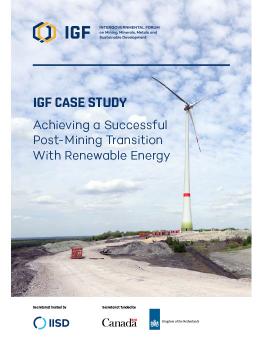
IGF Case Study: Achieving a Successful Post-Mining Transition With Renewable Energy
This report examines how two former mine sites were converted into spaces generating renewable energy in British Columbia, Canada and Ruhr, Germany.
The use of renewable energy technologies– including solar panels, wind turbines, and electric vehicles–has many benefits, from mitigating greenhouse gas emissions to diversifying the energy mix to reducing our dependence on fossil fuels.
In recent years, the mining industry has undertaken efforts to contribute to the renewable energy transition, including through the conversion of brownfields to brightfields. This entails transforming contaminated land or abandoned mine sites (brownfields) into areas that can generate renewable energy, most typically in the form of solar developments (brightfields). This practice not only contributes to the renewable energy transition but also serves to convert what would be a financial liability into an economic opportunity. Brownfield to brightfield conversion has increased significantly in recent years; for example, within the United States, the government vetted more than 80,000 brownfields for renewable energy development.
Former mine sites can be suitable locations for solar and wind power projects. The remediation process—the process of restoring the land—involves clearing the sites of any above-ground structures. Brownfields are then typically converted into sites suited to the installation of solar arrays and wind turbines. Former mine sites are also typically located in close proximity to power lines, which ultimately makes connecting to the grid easier.
This report from the Intergovernmental Forum on Mining, Minerals, Metals and Sustainable Development (IGF) shares case studies of renewable energy conversion from two different IGF member jurisdictions, both of which involved transforming a former mine site into a space used for renewables. The first case study outlines the efforts of SunMine, a solar farm within the interior of British Columbia. The second case study presents the conversion of a former coal mine site into a wind park in Ruhr, Germany.
Participating experts
You might also be interested in
ASEAN-IGF Minerals Cooperation: Scoping study on critical minerals supply chains in ASEAN
IGF-ASEAN study exploring opportunities arising from rising demand for critical minerals and metals to fuel the energy and digital transitions.
Searching for Critical Minerals? How metals are produced and associated together
Outlining how metals are produced and are associated together in mineral deposits, focusing on critical minerals for the energy transition.
The Impacts of Climate Change on the Mining Sector
This brief provides an overview of how climate change will affect the global mining sector.
A Brief Guide to Batteries
An overview of battery technology and related minerals for policy-makers and researchers working on the energy transition.